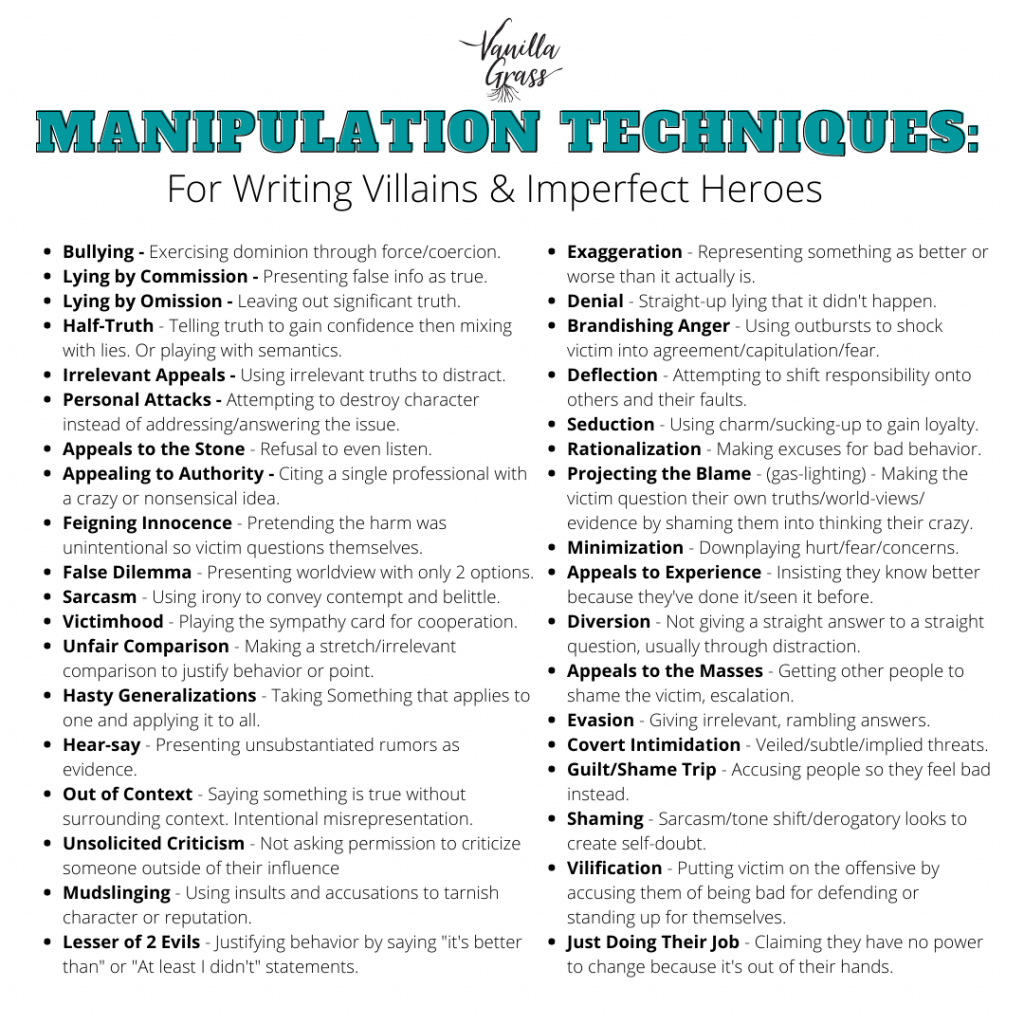Ever read books with villains who left you deliciously unsettled by the end?
Or have you ever watched a show and sat on your couch yelling at the protagonist to run as far and as fast as possible to get away from a villain who is clearly the epitome of evil?
Have you ever wanted to write villains like that for your story?
Yes? Yes!
And why wouldn’t you? The best stories not only have dynamic protagonists but also complex, BELIEVABLE villains.
And how do you write a believable, cringy, chill-inducing villain?
Why, with manipulation techniques, of course.

The Most Effective Way to Make Your Reader Love to Hate Your Villains
What makes an effective villain? Relatability. Or the reader being able to see the wrongs inflicted by your villain as wrongs others have inflicted on them. And what’s something every person on this earth has experienced and hates?
Manipulation.
Manipulation makes people feel invalidated, shameful, guilty, confused, uncertain about their own experience, angry, oppressed, dejected, and like they don’t have a say in anything.
That’s why both fictional and real-life villains use this technique constantly.
- It works!!
- It works!!
- Their victims don’t usually realize when it’s happening and can’t defend themselves…so it works!!
But before we continue, it’s important to know the difference between manipulation and persuasion.
Manipulation vs. Persuasion SmackDown

Let’s take a moment to get down and dirty.
What is Persuasion?
Persuasion is a win-win situation for the persuader and the persuadee.
It is when the person trying to convince another truly believes they can help the person improve their life or situation. In turn, it is also when the person being persuaded ends up truly believing they made the right choice for themselves.
It is also when the person trying to do the convincing is okay with the other person saying “No.” They don’t want someone on board who doesn’t fully agree or feels bad about the decision.
What Persuasion is not:
- Forcing someone to give an answer they don’t want to give or seem reluctant to embrace.
- Making someone feel bad about their decisions.
- Win-lose or lose-lose situations where one of the parties involved isn’t completely satisfied.
I would like to take this a step further. Would it be okay if I shared something with you that you might disagree with?
Intent Is Not Enough to Separate Persuasion From Manipulation.

It’s not. Sorry. Not sorry.
And this is important to know if you want to write a masterful villain.
Why?
Because complex villains need to believe they know better than everyone else and that what they’re doing is for the best, if not for the person directly, than for humanity or justice or yada-yada soapbox moments, right?
So, if we could sum up the difference between manipulation and persuasion, what would it be?
Implementation
I don’t care how passionate the missionaries on the doorstep are about saving your soul and the message they carry, if they’re employing techniques that cause bad feelings, they’re manipulators.
Yes or yes?
Yes!
But wait, Carolyn. Are you saying that as long as people who may have the intent to manipulate implement persuasion techniques correctly, they are not being manipulative?
Interesting question.
Can a Manipulator Implement Persusasion Techniques?

The short answer?
Yes.
But!
Not for long. And that is where intent does come into play.
But wait, again–I thought you just said intent isn’t the difference between persuading and manipulating? You’re going back on your word!
I am. But only to prove that I am not.
If you can have the best intentions and still manipulate people, then it‘s just as possible to have the worst intentions and still persuade people. That’s why intentions make no difference between persuasion and manipulation.
HOWEVER,
In the end, the dissonance or harmony between intent and implementation is the difference between villains and heroes. The difference between noble goals going terribly wrong and evil goals going swimmingly.
Yes and yes?
Wait…
Not sure?
Let’s take a look at what I mean.
Effective Villains Use Manipulation and Persuasion Techniques

A good villain knows that if they push the kettle too close to the edge, it will fall and break. To avoid this, they walk the line, playing nice when necessary and dirty when they feel their victim needs a jolt.
In this way, perfectly acceptable persuasion techniques are poisoned by the intent of the villain and their inevitable use of manipulation techniques.
This is a two wrongs don’t make a right, but neither does a wrong and a right make a right kind of situation.
You can see this all the time in movies and books.
Let’s skip the teen drama movies that are rife with the pettiest forms of manipulation and the weakest forms of persuasion and jump into something a little heavier.
Ever seen the movie…
FROZEN?

Prince Hans is a fantastic villain.
Why?
Because he is a fantastic persuader. And because his intentions get the best of him until he can’t help but manipulate as well.
He was so close! Soooo close. But he just couldn’t get it together, villain-style.
So, what were some of the techniques he used and where did he start losing it?
Why Frozen‘s Villain, Prince Hans, is a Master Persuader…and Manipulator

Master Persuasion Techniques Hans Uses With Anna:
- Mirroring: Prince Hans identifies Princess Anna, runs into her (on purpose, am I right?), and then mirrors what she does. She’s silly, he’s silly. She’s a little awkward, so is he. They have their ADORABLE song about how they’re meant to be, and he goes along with her sandwiches. He mirrors her facial expressions, her enthusiasm level, her love of music. Daaaaaang. He’s got this down.

- Building Trust: Prince Hans doesn’t ride on his charm alone. He works to do things that are genuinely helpful to Princess Anna. He indebts himself to her and creates a bond of trust. Oh, your sister just screamed at you? I got you boo, you do you. A cringy old man is accusing you and your sister of evils? I’ll defend you! Back off, bruh! Oh yeah, he’s scoring serious trust brownie points with Anna.

- Presenting Himself as an Authority: Prince Hans wants to rule the kingdom someday, so he has to prove he’s capable of it. No coup has ever been inspired by a lack-luster belly scratcher. When Anna leaves, he steps up (with her authority to back him, no less, because of the trust he already built!). He does genuine acts of good, setting aside monetary benefits to aid the people of the kingdom to win support and to prove he can handle the job.
Are any of these dishonest manipulation techniques? No. We just see them that way later when he reveals his true intent.
These persuasion techniques only turn into manipulation when they’re tainted by his evilness and desperation…What’s a villain gonna do?
Master Manipulator Techniques Hans Uses Against Anna:
- Seduction: Remember how we talked about mirroring above? This can be a genuine way to find relatability in a person. You like sushi? ME TOO! We are now besties. But when you’re an evil villain, the desire to form a commonality is not to get to know the person better or help them make a good choice, it is to benefit yourself. When a person taints mirroring with evil intentions, it becomes seduction. This reaches its pinnacle for Prince Hans when he turns his charm into a weapon to kill Anna by getting her alone with him in a room because she thinks he will kiss her and save the kingdom. Ouch.
- Victimhood: Prince Hans does this subtly because he knows no one likes a whiner, but his personality is rife with this manipulation technique because it’s part of his false truth or identity. My brothers were the worst! They ignored me for a year! He sees a need in Anna, which he could persuade to turn to good, and instead exploits it with manipulation. You’re lonely. I’m lonely. We are the same. This is a form of ill-intentioned trust-building that manipulates the victim.
- Isolation: Fortunately for Hans, this one wasn’t hard. How does he get Anna away from her support network (i.e. her kingdom and servants…which she may or may not have)? Easy. She wants to go away on a journey BY HERSELF and he lets her. This is a great example of turning a trust-building technique sour with manipulation. You want to make a bad choice? I support you. This is where intent makes a difference in implementation. If he truly wanted to help Anna, he would have tried to persuade her into a more cogent and sensible choice.
Okay, but like, your lists just proved that intention is what makes the difference between manipulation and persuasion…
To that, I counter:
Ineffective Heroes Use Persuasion and Manipulation Techniques

Ever heard the delightfully encouraging maxim: The pathway to hell is paved with good intentions?
Heroes fall into this category a lot. Thankfully, when the tendency to manipulate is present in a hero, it is a flaw at the beginning of the book that they are looking to overcome. Their intentions start good and remain good throughout the book, but the hero learns that they can’t force other people to do what they want.
Again, we’ll skip the high school dramas rife with unreliable narrators and flaw-riddled protagonists, and skip to something a little thicker:
FROZEN!
Except this time, let’s take a look at Elsa.
Why Frozen‘s Elsa is a Master Manipulator…and Persuader

But wait…Doesn’t Elsa run away from everyone because she wants to be alone?
Yep.
Why does she do that? Because she’s manipulated herself into making bad choices.
Self-manipulation is the most common type of protagonist flaw found in stories. It is what facilitates the false-truth or false-belief in a character that drives all their poor choices in a book.
Vanilla Grass
So, let’s take a look:
Manipulation Techniques Elsa Uses Against Herself:
- Isolation: Remember how Hans got Anna to separate herself from help? Elsa does this ten times over. She convinces herself that she’s better off on her own and cuts off everyone who loves her. This is a classic manipulation technique and prevents escape from the situation. Good thing Anna isn’t having it.

- Guilt/Shame Trip: Another favorite of manipulators, Elsa uses this to destroy herself and reinforce her false truth: I hurt people. This prevents her from forming relationships or believing in her own worth.e
- False Dilemma: This is the tell-tale black and white situation. It’s either this! Or This! In Elsa’s case, she’s presented herself with a limited worldview. I either hide from people or I hurt people. This manipulation technique is used to limit the victim and keep them trapped in their fear. Something Elsa knocks out in spades.

Persuasion Techniques Elsa Uses For Herself:
Luckily, Elsa is not the true villain here, though she could have been. She, however, evolves as a character and stops falling prey to her own manipulation so she can grow as a character.
For example, she implements:
- Building Trust: When Elsa runs away, she starts to allow herself to use her abilities and see what she’s actually capable of when she’s not controlled by fear. While this doesn’t take her to the complete path to recovery, it is an important step in moving away from the fear she used to manipulate herself with.
- Overcoming Objections: Now, this one sometimes raises alarms with people because it sounds like manipulation. This isn’t forcing a “yes” despite objections, but helping a person find a way through their fears. For Elsa, this comes when Anna is in danger. Elsa realizes her excuses for running–I hurt people, I only cause trouble, I can’t help anyone, I’m afraid–will only cause her to lose Anna if she continues. She uses the power of love to overcome her fear and comes to the realization that doing nothing will cause more harm than trying which finally gets her butt moving in the right direction. The power of persuasion!
- Accepting Responsibility: Manipulators never accept responsibility. And by running away from her problems, Elsa wasn’t either. However, at the end of the story when she’s fulfilling her story arc, she realizes she has to. She accepts that she froze the kingdom, that running doesn’t solve anything, and that she’s the only one who can fix the mess she (unintentionally) made. Master persuaders convince people they need to own up to their mistakes AND convince people there’s a way to fix it.
How to Use Manipulation and Persuasion Techniques to Create Memorable Villains
With some great examples under our belt, are you ready to turn your villains into master manipulators?
Are you ready for readers to want to throw your book across the room and never stop reading it at the same time?
To yell “don’t trust them!” to your protagonist as they gulp down page after page?
Great!
Now, before I give you the secret formula to complex villains, I want to give a caveat. Heavy action, good vs. pure-evil movies, and books (think Marvel or LOTR) don’t have master villains. They have evil. And while evil sometimes tries to persuade people to join their cause, they usually just plan to annihilate and subjugate everyone regardless of where their loyalties lie.

The Secret Formula for Creating Master Villains
- Have your villain establish trust through good actions and persuasion techniques. Ted Bundy is a real life monster who charmed the pants off his future victims and peers. Clayton in Tarzan provided protection. Ursula commiserated with Arial. Syndrome gave Mr. Incredible a job and a renewed purpose in life. Even Thanos took in a little girl in the Avenger’s series. This step usually starts taking place leading from act one and through the first half of act 2 in a 3-act structure.
- Slowly reveal the villain’s intentions. This will start to feel like a betrayal of trust for the protagonist and, if done right, the reader. They’ll say, “Hey! Wait a minute…I thought you were being genuine.” This shouldn’t be a quick turn. But a slow dawning of realization that the person may not be as good as they lead the protagonist to believe. This slow turning usually starts around the midpoint.
- Switch to full manipulation techniques. When the villain can’t hide their intentions anymore (because…you know…their egos are just too big to keep it under wraps), they switch to full-on manipulation techniques. This is Hans’ “If only there were someone who loved you” moment with Anna, or Syndrome’s “I’m your biggest fan” revelation. This snap to full manipulation usually takes place around the crisis at the end of act 2.
- And finally, have the villain drop all pretenses and jump into full go-big-or-go-home mode. This is the natural progression for manipulators in real life. Their tactics get more and more desperate until, unsuccessful, they rage-quit and lash out in extreme ways. Destruction-mode usually occurs at the climax.
And voila! Masterful villains who take your protagonist and reader for a ride!
A Comprehensive List of Manipulation Techniques Used by Villains
For a printable download of the manipulation techniques used by villains in the list below, see the bottom of the page!
- Bullying – Exercising dominion through force/coercion.
- Lying by Commission – Presenting false info as true.
- Lying by Omission – Leaving out significant truth.
- Half-Truth – Telling truth to gain confidence then mixing with lies. Or playing with semantics.
- Irrelevant Appeals – Using irrelevant truths to distract.
- Personal Attacks – Attempting to destroy character instead of addressing/answering the issue.
- Appeals to the Stone – Refusal to even listen.
- Appealing to Authority – Citing a single professional with a crazy or nonsensical idea.
- Feigning Innocence – Pretending the harm was unintentional so victim questions themselves.
- False Dilemma – Presenting worldview with only 2 options.
- Sarcasm – Using irony to convey contempt and belittle.
- Victimhood – Playing the sympathy card for cooperation.
- Unfair Comparison – Making a stretch/irrelevant comparison to justify behavior or point.
- Hasty Generalizations – Taking Something that applies to one and applying it to all.
- Here-say – Presenting unsubstantiated rumors as evidence.
- Out of Context – Saying something is true without surrounding context. Intentional misrepresentation.
- Unsolicited Criticism – Not asking permission to criticize someone outside of their influence
- Mudslinging – Using insults and accusations to tarnish character or reputation.
- Lesser of 2 Evils – Justifying behavior by saying “it’s better than” or “At least I didn’t” statements.
- Exaggeration – Representing something as better or worse than it actually is.
- Denial – Straight-up lying that it didn’t happen.
- Brandishing Anger – Using outbursts to shock victim into agreement/capitulation/fear.
- Deflection – Attempting to shift responsibility onto others and their faults.
- Seduction – Using charm/sucking-up to gain loyalty.
- Rationalization – Making excuses for bad behavior.
- Projecting the Blame – (gas-lighting) – Making the victim question their own truths/world-views/ evidence by shaming them into thinking their crazy.
- Minimization – Downplaying hurt/fear/concerns.
- Appeals to Experience – Insisting they know better because they’ve done it/seen it before.
- Diversion – Not giving a straight answer to a straight question, usually through distraction.
- Appeals to the Masses – Getting other people to shame the victim, escalation.
- Evasion – Giving irrelevant, rambling answers.
- Covert Intimidation – Veiled/subtle/implied threats.
- Guilt/Shame Trip – Accusing people so they feel bad instead.
- Shaming – Sarcasm/tone shift/derogatory looks to create self-doubt.
- Vilification – Putting victim on the offensive by accusing them of being bad for defending or standing up for themselves.
- Just Doing Their Job – Claiming they have no power to change because it’s out of their hands.
- Escalating Intensity – Continually pressuring and upping the emotional intensity level to wear down the victim.
How to Start Adding Manipulation and Persuasion into the Villains in Your Book

Now that you have the recipe for villain success, sit down and look at your favorite movie or book and write a simple outline of what persuasion techniques they use in the beginning, when and how things start to shift, when they abandon persuasion altogether and switch to manipulation, and when they give up on trying to force people into their beliefs and decide to destroy everyone instead.
Then, write down a couple of your favorite persuasion and manipulation techniques and put them in an outline that goes from good to bad.
Or, if you have a story already written (go you!), then sit down and write out how your villain acts in the transition to act two, the mid-point, the crises, and the climax. If they’re progressively turning to manipulation and rage, you’re spot on. If their signals are mixed, consider tweaking them so you have a natural flow that readers can relate to.
And if you’re looking for further help writing a book that sells, check out these 7 basic story plots, or this article on story structure. Or, if you want to know how your villain is doing, learn what questions to ask your alpha and beta readers.
Most importantly, keep writing! We believe in you.






I have read so many posts about the blogger lovers however this post is really a good piece of writing, keep it up